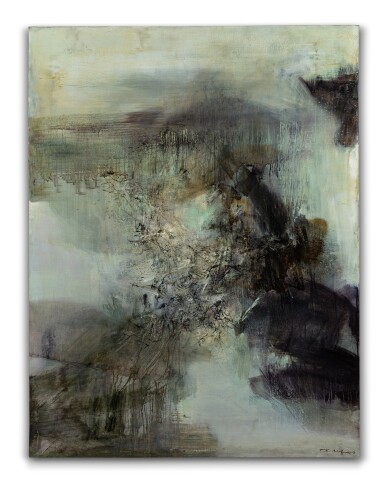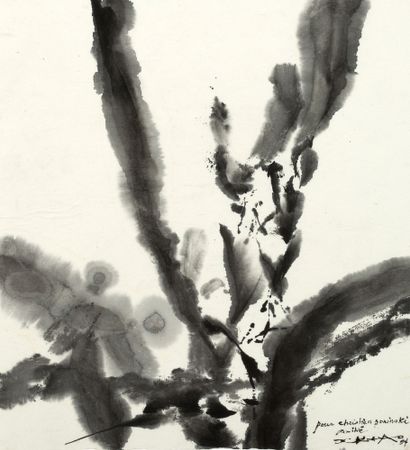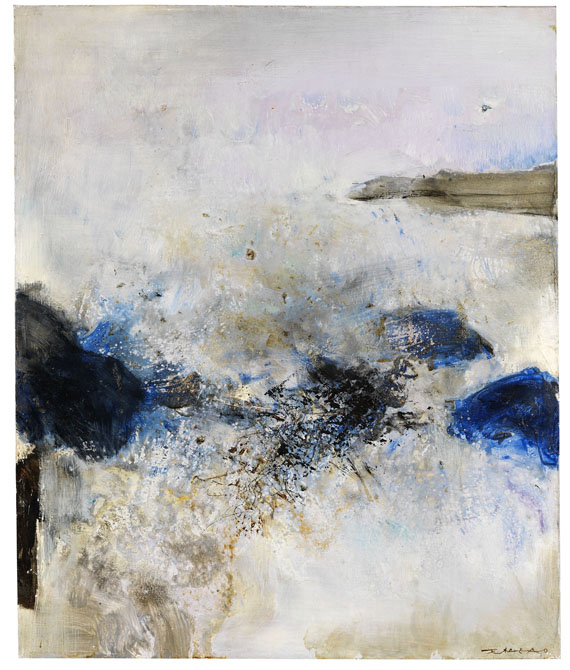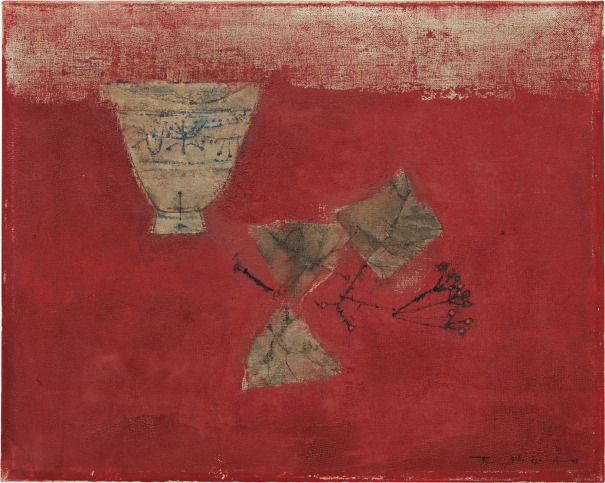◆ ✱ 5 Property of an Important Asian Collector Zao Wou-Ki Follow 04.01.79 1979 signed ‘Wou-Ki [in Chinese] ZAO’ lower right; further signed and titled ‘ZAO WOU-KI "4.1.79"’ on the reverse oil on canvas 250 x 260 cm. (98 3/8 x 102 3/8 in.) Painted in 1979, this work is to be accompanied by a certificate of authenticity issued by the Foundation Zao Wou-Ki This work will be referenced in the archive of the Foundation Zao Wou-Ki and will be included in the artist's forthcoming catalogue raisonné prepared by Françoise Marquet and Yann Hendgen (Information provided by Foundation Zao Wou-Ki .
Provenance Private Collection, Asia (acquired directly from the artist) Private Collection, Asia Acquired from the above by the present owner Exhibited Luxembourg, Musée d’Histoire et d’Art, Zao Wou-Ki Grands tableaux de 1964 à 1979 , 1980, no. 30 Charleroi, Palais des Beaux-Arts, Grands tableaux de Zao Wou-Ki , 1980, no. 30 Paris, Galeries nationales du Grand Palais; Fukuoka Art Museum; Tokyo, Nihonbashi Art Gallery; Fukui Prefectural Museum; Kyoto, National Museum of Modern Art; Kamakura, Museum of Modern Art, Zao Wou-Ki Peintures, encres de Chine. 1950-1981 , 1981-1982, no. 43 Hong Kong Arts Centre, Paintings by Zao Wou-Ki 1954-1981 , 1982 Paris, Artcurial, centre d’art plastique contemporain, Zao Wou-Ki 1955-1988 , 1988, p. 20 (illustrated) Aix-en-Provence, Fondation Vasarely, Zao Wou-Ki collection personnelle, 1955-1989 , 1991, no.11, p. 19 (illustrated) Kaohsiung Museum of Arts, A retrospective of Zao Wou-Ki , 1996, pp. 171-172 (illustrated) Literature Jean Leymarie, ed., Zao Wou-Ki , Paris, 1986, no. 228, p. 280 (illustrated) Françoise Marquet and Yann Hendgen, ed., Zao Wou-Ki 1935–2008 , Hong Kong, 2010, p. 219 (illustrated) Video Eastern Taoism and European Modernism Intersect in Zao Wou-Ki's '04.01.79' Jonathan Crockett, Deputy Chairman of Asia, discusses the dance of Eastern and Western influences in Zao Wou-Ki's '04.01.79'. An all-encompassing representation of the Chinese-Parisian artist's mature stage of his life after residing in Paris for over three decades, the painting is a culmination of Eastern ink techniques and Western abstraction. In '04.01.79', Zao Wou-Ki uses this unique style to bring forms to amorphous forces of nature such as fog and light. Catalogue Essay Standing at an impressive height of 2 and a half metres, 04.01.79 is a rare and large-scale work by Zao Wou-Ki one of the greatest modern Chinese masters. Executed in 1979, the present work embodies the pivotal stylistic transition from the artist’s middle to late period of abstract paintings. The largest painting from the 1970s by the artist to ever come to auction, as well as among the top 10 of his largest works on the market, 04.01.79 is presented to the public for the first time. Zao Wou-Ki perfectly captures in 04.01.79 the essence of traditional Chinese ink landscapes from the Song and Yuan Dynasties, complemented by the virtues of Western painting in its use of colour and tones. The result is an image of implicit scenic beauty, evoking the grandeur of magnificent landscapes punctuated by high mountains and trees. Zao Wou-Ki The Man and His Art “The myriad things in the universe are conceived by existence; Existence arises from nothingness; and all shall eventually return to the boundless.” – Zao Wou-ki (“Boundless”) was named by his grandfather after the Tao Te Ching , an ancient text by Chinese philosopher Laozi. Despite being the eldest son, Zao Wou-ki did not wish to continue the family business as a banker, and instead grew up especially fond of art. At the age of 15, Zao enrolled in the National Hangzhou Art Academy. Influenced by Western artists like Cézanne and Matisse, he aspired to break free from the confines of traditional Chinese painting. Zao graduated in 1941 after completing his 6-year training programme, after which he was retained by his teacher Lin Fengmian to stay on as a teaching assistant. In hopes of pursuing wider artistic possibilities, the young artist travelled to France in 1948 with his family’s support. This supposed sojourn ultimately became a permanent residency. Many Chinese artists who came to France to further their education before Zao’s time were part of the work-study programme –a practice of working while studying part-time as a form of self-support that was promoted by China’s Republican government in its early years. The programme was about maintaining a national core of traditional Chinese learning while equipping it with the functionalities of Western learning. Artists like Lin Fengmian and X
◆ ✱ 5 Property of an Important Asian Collector Zao Wou-Ki Follow 04.01.79 1979 signed ‘Wou-Ki [in Chinese] ZAO’ lower right; further signed and titled ‘ZAO WOU-KI "4.1.79"’ on the reverse oil on canvas 250 x 260 cm. (98 3/8 x 102 3/8 in.) Painted in 1979, this work is to be accompanied by a certificate of authenticity issued by the Foundation Zao Wou-Ki This work will be referenced in the archive of the Foundation Zao Wou-Ki and will be included in the artist's forthcoming catalogue raisonné prepared by Françoise Marquet and Yann Hendgen (Information provided by Foundation Zao Wou-Ki .
Provenance Private Collection, Asia (acquired directly from the artist) Private Collection, Asia Acquired from the above by the present owner Exhibited Luxembourg, Musée d’Histoire et d’Art, Zao Wou-Ki Grands tableaux de 1964 à 1979 , 1980, no. 30 Charleroi, Palais des Beaux-Arts, Grands tableaux de Zao Wou-Ki , 1980, no. 30 Paris, Galeries nationales du Grand Palais; Fukuoka Art Museum; Tokyo, Nihonbashi Art Gallery; Fukui Prefectural Museum; Kyoto, National Museum of Modern Art; Kamakura, Museum of Modern Art, Zao Wou-Ki Peintures, encres de Chine. 1950-1981 , 1981-1982, no. 43 Hong Kong Arts Centre, Paintings by Zao Wou-Ki 1954-1981 , 1982 Paris, Artcurial, centre d’art plastique contemporain, Zao Wou-Ki 1955-1988 , 1988, p. 20 (illustrated) Aix-en-Provence, Fondation Vasarely, Zao Wou-Ki collection personnelle, 1955-1989 , 1991, no.11, p. 19 (illustrated) Kaohsiung Museum of Arts, A retrospective of Zao Wou-Ki , 1996, pp. 171-172 (illustrated) Literature Jean Leymarie, ed., Zao Wou-Ki , Paris, 1986, no. 228, p. 280 (illustrated) Françoise Marquet and Yann Hendgen, ed., Zao Wou-Ki 1935–2008 , Hong Kong, 2010, p. 219 (illustrated) Video Eastern Taoism and European Modernism Intersect in Zao Wou-Ki's '04.01.79' Jonathan Crockett, Deputy Chairman of Asia, discusses the dance of Eastern and Western influences in Zao Wou-Ki's '04.01.79'. An all-encompassing representation of the Chinese-Parisian artist's mature stage of his life after residing in Paris for over three decades, the painting is a culmination of Eastern ink techniques and Western abstraction. In '04.01.79', Zao Wou-Ki uses this unique style to bring forms to amorphous forces of nature such as fog and light. Catalogue Essay Standing at an impressive height of 2 and a half metres, 04.01.79 is a rare and large-scale work by Zao Wou-Ki one of the greatest modern Chinese masters. Executed in 1979, the present work embodies the pivotal stylistic transition from the artist’s middle to late period of abstract paintings. The largest painting from the 1970s by the artist to ever come to auction, as well as among the top 10 of his largest works on the market, 04.01.79 is presented to the public for the first time. Zao Wou-Ki perfectly captures in 04.01.79 the essence of traditional Chinese ink landscapes from the Song and Yuan Dynasties, complemented by the virtues of Western painting in its use of colour and tones. The result is an image of implicit scenic beauty, evoking the grandeur of magnificent landscapes punctuated by high mountains and trees. Zao Wou-Ki The Man and His Art “The myriad things in the universe are conceived by existence; Existence arises from nothingness; and all shall eventually return to the boundless.” – Zao Wou-ki (“Boundless”) was named by his grandfather after the Tao Te Ching , an ancient text by Chinese philosopher Laozi. Despite being the eldest son, Zao Wou-ki did not wish to continue the family business as a banker, and instead grew up especially fond of art. At the age of 15, Zao enrolled in the National Hangzhou Art Academy. Influenced by Western artists like Cézanne and Matisse, he aspired to break free from the confines of traditional Chinese painting. Zao graduated in 1941 after completing his 6-year training programme, after which he was retained by his teacher Lin Fengmian to stay on as a teaching assistant. In hopes of pursuing wider artistic possibilities, the young artist travelled to France in 1948 with his family’s support. This supposed sojourn ultimately became a permanent residency. Many Chinese artists who came to France to further their education before Zao’s time were part of the work-study programme –a practice of working while studying part-time as a form of self-support that was promoted by China’s Republican government in its early years. The programme was about maintaining a national core of traditional Chinese learning while equipping it with the functionalities of Western learning. Artists like Lin Fengmian and X



.jpg)







.jpg)
.jpg)
.jpg)

Testen Sie LotSearch und seine Premium-Features 7 Tage - ohne Kosten!
Lassen Sie sich automatisch über neue Objekte in kommenden Auktionen benachrichtigen.
Suchauftrag anlegen